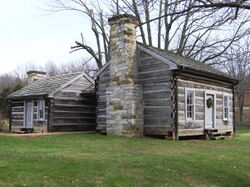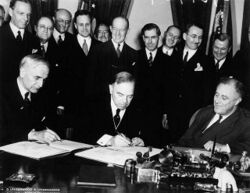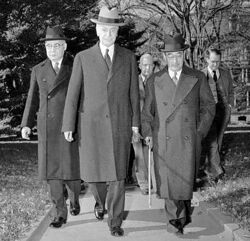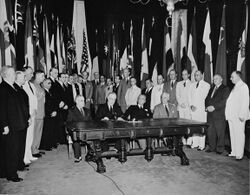Biography:Cordell Hull
Cordell Hull | |
|---|---|
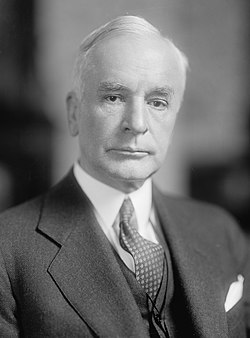 Hull, c. 1905–1945 | |
| 47th United States Secretary of State | |
| In office March 4, 1933 – November 30, 1944 | |
| President | Franklin D. Roosevelt |
| Deputy | William Phillips Sumner Welles Edward Stettinius Jr. |
| Preceded by | Henry L. Stimson |
| Succeeded by | Edward Stettinius Jr. |
| United States Senator from Tennessee | |
| In office March 4, 1931 – March 3, 1933 | |
| Preceded by | William Emerson Brock |
| Succeeded by | Nathan L. Bachman |
| Member of the U.S. House of Representatives from Tennessee's Tennessee04 4th district | |
| In office March 4, 1923 – March 3, 1931 | |
| Preceded by | Wynne F. Clouse |
| Succeeded by | John R. Mitchell |
| In office March 4, 1907 – March 3, 1921 | |
| Preceded by | Mounce Gore Butler |
| Succeeded by | Wynne F. Clouse |
| Chair of the Democratic National Committee | |
| In office November 2, 1921 – July 22, 1924 | |
| Preceded by | George White |
| Succeeded by | Clem L. Shaver |
| Personal details | |
| Born | October 2, 1871 Olympus, Tennessee, U.S. |
| Died | July 23, 1955 (aged 83) Washington, D.C., U.S. |
| Resting place | Washington National Cathedral |
| Political party | Democratic |
| Spouse(s) | Rose Frances (Witz) Whitney (m. 1917; died 1954) |
| Education | National Normal University Cumberland University (LLB) |
| Awards | Nobel Peace Prize |
| Signature | |
| Military service | |
| Allegiance | United States |
| Branch/service | Tennessee Volunteer Infantry |
| Rank | Captain |
| Battles/wars | Spanish–American War |
Cordell Hull (October 2, 1871 – July 23, 1955) was an American politician from Tennessee and the longest-serving U.S. Secretary of State, holding the position for 11 years (1933–1944) in the administration of President Franklin Delano Roosevelt during most of World War II. Before that appointment, Hull represented Tennessee for two years in the United States Senate and 22 years in the House of Representatives.
Hull received the Nobel Peace Prize in 1945 for his role in establishing the United Nations , and was referred to by President Roosevelt as the "Father of the United Nations".[1]
Early life and education
Cordell Hull was born in a log cabin in Olympus, Tennessee, which is now part of Pickett County, Tennessee, but was then part of Overton County.[citation needed] He was the third of the five sons of William Paschal Hull (1840–1923) and Mary Elizabeth Hull (née Riley) (1841–1903). His brothers were named Orestes (1868), Sanadius (1870), Wyoming (1875), and Roy (1881).[citation needed]
According to John Gunther, Hull's father had tracked down and killed a man because of a blood feud.[2] His mother was a descendant of Isaac Riley, who was granted 200 acres (0.81 km2) in near Byrdstown in Pickett County, for Revolutionary War service, as well as Samuel Wood who emigrated from Leicestershire, England on the ship Hopewell and fought in the Virginia Militia. Hull's mother's family (Riley-Wood) had numerous ancestors who fought in the Revolutionary War. Hull devoted a section in his memoirs "Cabin on the Hill" to dispelling an old rumor that his father was part Cherokee Indian,[3] and subsequent documented family history has confirmed his ancestry.[citation needed]
Hull attended college from 1889 until 1890. He gave his first speech at the age of 16. At the age of 19, Hull became the elected chairman of the Clay County Democratic Party. Hull studied at National Normal University (later merged with Wilmington College, Ohio) from 1889 until 1890. In 1891, he graduated from Cumberland School of Law at Cumberland University and was admitted to the bar.[citation needed]
Early career
Hull served in the Tennessee House of Representatives from 1893 until 1897. During the Spanish–American War, he served in Cuba as a captain in the Fourth Regiment of the Tennessee Volunteer Infantry.[citation needed]
From 1913 to 1917, Hull served as a local judge; later he was elected to the United States House of Representatives where he served 11 terms (1917–1931 and 1923–1931) totaling 22 years. As a member of the powerful Ways and Means committee, he fought for low tariffs[4] and claimed authorship of the federal income tax laws of 1923 and 1926 and the inheritance tax of 1926. After his defeat in the congressional election of 1920, he served as chairman of the Democratic National Committee. He was one of several candidates for president at the 1928 Democratic National Convention, which ultimately chose Al Smith as nominee. Hull was influential in advising Albert Gore, Sr. to run for the U.S. Congress in 1938. Hull recorded twenty-five years of combined service in the House and the Senate.[citation needed]
Secretary of State
Hull won election to the Senate in 1930, but resigned from it in 1933 to become Secretary of State. Hull became one of Roosevelt's strongest Southern allies during the 1932 presidential campaign.[4]
Roosevelt named him Secretary of State and appointed him to lead the American delegation to the London Economic Conference, which then collapsed when Roosevelt rejected its main plans. In 1943, Hull served as United States delegate to the Moscow Conference. At all times, his main objective was to enlarge foreign trade and lower tariffs. The more important issue of the American role in World War II was handled by Roosevelt who worked through Sumner Welles, the second-ranking official at the State Department. Hull did not attend the summit meetings that Roosevelt had with Winston Churchill and Josef Stalin.[5][page needed] In 1943, Hull finally destroyed Welles's career by threatening to expose his homosexuality.[6]
In a speech in 1937, New York City Mayor Fiorello H. La Guardia said that brown-shirted Nazis ought to be featured as the "climax" of a chamber of horrors in the upcoming World's Fair. The Nazi government organ, Der Angriff, called the mayor a "Jewish Ruffian" who had been bribed by Jewish and Communistic agents and was a criminal disguised as an officeholder.[7] In the ensuing exchanges, Hull sent a letter of regret to Berlin for intemperate comments on both sides, but he also explained the principle of freedom of speech. As the response of Nazi propaganda organs rose in pitch to include characterizing American women as "prostitutes," Hull sent a letter of protest to Berlin, which elicited an "explanation" but no apology.[8]
In 1938, Hull engaged in a dialog with Mexican Foreign Minister Eduardo Hay concerning the failure of Mexico to compensate Americans who lost farmlands during agrarian reforms in the late 1920s. He insisted that compensation must be "prompt, adequate and effective". Though the Mexican Constitution guaranteed compensation for expropriation or nationalization, nothing had yet been paid. While Hay admitted Mexico's responsibility, he replied that there is "no rule universally accepted in theory nor carried out in practice which makes obligatory the payment of immediate compensation...."[citation needed] The so-called "Hull formula" has been adopted in many treaties concerning international investment but is still controversial, especially in Latin American countries, which have historically subscribed to the Calvo doctrine, which suggests that compensation is to be decided by the host country and that as long as there is equality between nationals and foreigners and no discrimination, there can be no claim in international law. The tension between the Hull formula and the Calvo doctrine is still important in the law of international investment.[citation needed]
Hull pursued the "Good Neighbor Policy" with Latin American nations, which has been credited with preventing Nazi subterfuge in that region. Hull and Roosevelt also maintained relations with Vichy France, which Hull credited with allowing General Henri Giraud's forces to join allied forces in the North African campaign against Germany and Italy.[3][page needed]
Hull also handled formal statements with foreign governments. Notably he sent the Hull note just prior to the Pearl Harbor attack, which was formally titled "Outline of proposed Basis for Agreement Between The United States and Japan." Hull received news of the attack while he was outside his office. The Japanese ambassador Kichisaburō Nomura and Japan's special envoy Saburō Kurusu were waiting to see Hull with a 14-part message from the Japanese government that officially notified of a breakdown in negotiations. The United States had broken Japanese encryption, and Hull knew the message contents. He blasted the diplomats: "In all my fifty years of public service, I have never seen such a document that was more crowded with infamous falsehood and distortion."[9]
Hull chaired the Advisory Committee on Postwar Foreign Policy, which was created in February 1942.[citation needed]
When the Free French Forces of Charles de Gaulle occupied the islands of Saint-Pierre and Miquelon, south of Newfoundland, in December 1941, Hull lodged a very strong protest and went as far as referring to the Gaullist naval forces as "the so-called Free French." His request to have the Vichy governor reinstated was met with strong criticism in the American press. The islands remained under the Free French until the end of the war. Hull, who always held de Gaulle in disregard, if not detestation, even before the incident, would never cease trying to maneuver against him during the rest of the war.[citation needed]
Jews and SS St. Louis incident
In 1939, Hull advised Roosevelt to reject the SS St. Louis, a German ocean liner carrying 936 Jews seeking asylum from Germany. Hull's decision sent the Jews back to Europe on the eve of the Holocaust. Some historians estimate that 254 of the passengers were ultimately murdered by the Nazis.[citation needed]
Okay ...there were two conversations on the subject between (Secretary of the Treasury) Morgenthau and Secretary of State Cordell Hull. In the first, 3:17 PM on 5 June 1939, Hull made it clear to Morgenthau that the passengers could not legally be issued U.S. tourist visas as they had no return addresses. Furthermore, Hull made it clear to Morgenthau that the issue at hand was between the Cuban government and the passengers. The U.S., in effect, had no role. In the second conversation at 3:54 PM on June 6, 1939, Morgenthau said they did not know where the ship was and he inquired whether it was "proper to have the Coast Guard look for it". Hull responded by saying that he didn't see any reason why it could not. Hull then informed him that he did not think that Morgenthau would want the search for the ship to get into the newspapers. Morgenthau said "Oh no. No, no. They would just—oh, they might send a plane to do patrol work. There would be nothing in the papers." Hull responded "Oh, that would be all right."[10]
In September 1940, First Lady Eleanor Roosevelt maneuvered with another State Department official to bypass Hull's refusal to allow Jewish refugees aboard a Portuguese ship, the SS Quanza, to receive visas to enter the U.S. Through her efforts, the Jewish refugees disembarked on September 11, 1940, in Virginia.[11] In a similar incident, American Jews sought to raise money to prevent the mass murder of Romanian Jews but were blocked by the State Department. "In wartime, in order to send money out of the United States, two government agencies had to sign a simple release—the Treasury Department under Henry Morgenthau and the State Department under Secretary Cordell Hull. Morgenthau signed immediately. The State Department delayed, delayed, and delayed, as more Jews were dying in the Transnistria camps."[12]
In 1940, Jewish representatives in the USA lodged an official complaint against the discriminatory policies the State Department was using against the Jews. The results were fatal: Hull gave strict orders to every USA consulate worldwide forbidding the issuing of visas to Jews ... At the same time a Jewish congressman petitioned Roosevelt, requesting his permission to allow twenty thousand Jewish children from Europe to enter the USA. The President did not respond to the petition.[13]
Establishing the United Nations
Hull was the underlying force and architect in the creation of the United Nations , as recognized by the 1945 Nobel Prize for Peace, an honor for which Franklin D. Roosevelt nominated him. During World War II, Hull and Roosevelt had worked toward the development of a world organization to prevent a third World War. Hull and his staff drafted the "Charter of the United Nations" in mid-1943.[14]
Later years
Hull resigned on November 30, 1944, due to failing health. To this day he remains the longest-serving US Secretary of State, having served for eleven years and nine months in the post. Roosevelt described Hull upon his departure as "the one person in all the world who has done his most to make this great plan for peace (the United Nations) an effective fact".[citation needed] The Norwegian Nobel Committee honored Hull with the Nobel Peace Prize in 1945 in recognition of his efforts for peace and understanding in the Western Hemisphere, his trade agreements, and his work to establish the United Nations.
In January 1948, Hull published his two-volume memoirs, an excerpt from which appeared in The New York Times.[15]
Personal life and death
At the age of 45, in 1917, Hull married a widow, Rose Frances (Witz) Whitney (1875–1954), of an Austrian Jewish family of Staunton, Virginia. The couple had no children. Mrs. Hull died at age 79, in Staunton, Virginia, in 1954. She is buried in Washington D.C. at Washington National Cathedral.[citation needed]
Hull died on July 23, 1955, at age 83, at his home in Washington, D.C., after a lifelong struggle with familial remitting-relapsing sarcoidosis (often confused with tuberculosis). He is buried in the vault of the Chapel of St. Joseph of Arimathea in the Washington National Cathedral.[citation needed]
Legacy
Hull's memory is preserved by Cordell Hull Dam on the Cumberland River near Carthage, Tennessee. The dam impounds Cordell Hull Lake, covering approximately 12,000 acres (49 km2).
His law school, Cumberland School of Law, continues to honor him with a Cordell Hull Speaker's Forum and the Moot Court Room.
Cordell Hull Birthplace State Park, near Byrdstown, Tennessee, was established in 1997 to preserve Hull's birthplace and various personal effects Hull had donated to the citizens of Pickett County, including his Nobel Peace Prize.
A segment of Kentucky highway routes 70, 90, 63, and 163, from Mammoth Cave National Park near Cave City south to the Tennessee State Line near Hestand, is named "Cordell Hull Highway", and is part of that state's scenic byway system.
The Cordell Hull Building, on Capital Hill in Nashville, Tennessee, is a secure 10-story building that contains the offices of the Tennessee Legislature.
The Eisenhower Executive Office Building (formerly the Old Executive Office Building) in Washington, DC, next to the White House, contains the ornately decorated "Cordell Hull Room" on the second floor, which is used for meetings. The room was Cordell Hull's office when he served as U.S. Secretary of State.
The U.S. Postal Service issued a 5-cent commemorative stamp honoring Cordell Hull on October 5, 1963.
Hull is one of the presidential cabinet members who are characters in the musical Annie.[16]
See also
- List of United States Cabinet members who have served more than eight years
Citations
- ↑ Hulen, Bertram D. (1946-10-25). "Charter Becomes 'Law of Nations', 29 Ratifying It". The New York Times: p. 1. https://www.nytimes.com/learning/general/onthisday/big/1024.html.
- ↑ Gunther, John (1950). Roosevelt in Retrospect. Harper & Brothers. pp. 132. https://archive.org/details/rooseveltinretro00gunt.
- ↑ 3.0 3.1 Cordell Hull, Memoirs
- ↑ 4.0 4.1 Benton, James C. (2022). Fraying Fabric: How Trade Policy and Industrial Decline Transformed America. University of Illinois Press. pp. 33–35. ISBN 978-0-252-04465-6. https://www.jstor.org/stable/10.5406/j.ctv31xf5rf.
- ↑ Charles E. Bohlen, Witness to History 1929–1969 (1973)
- ↑ Joseph Lelyveld (2017). His Final Battle: The Last Months of Franklin Roosevelt. Knopf Doubleday Publishing. p. 69. ISBN 9780345806598. https://books.google.com/books?id=hYg-DwAAQBAJ&pg=PA69.
- ↑ "Hull gives Reich Official 'Apology'". The New York Times: pp. 1, 8. March 5, 1937. https://timesmachine.nytimes.com/timesmachine/1937/03/06/94343952.pdf. "The Angriff carries a headline, 'Jewish ruffian La Guardia's new Insolence'..."
- ↑ Michael Zalampas (1989). Adolf Hitler and the Third Reich in American Magazines, 1923–1939. Popular Press. p. 108. ISBN 978-0879724627. https://books.google.com/books?id=WrcA0sAqwgsC&q=LaGuardia++cordell.hull+letter&pg=PA108.
- ↑ Mark Stoler; Molly Michelmore (2018). The United States in World War II: A Documentary History. Hackett. pp. 27–31. ISBN 9781624667497. https://books.google.com/books?id=7N5yDwAAQBAJ&pg=PA31.
- ↑ "USCG: Frequently Asked Questions". 2014-11-10. http://www.uscg.mil/history/faqs/St_Louis.asp.
- ↑ Buckley, Cara (July 8, 2007). "Fleeing Hitler and Meeting a Reluctant Miss Liberty". The New York Times. https://www.nytimes.com/2007/07/08/nyregion/08quanza.html.
- ↑ Gruber, Inside of Time p. 159 (2003).
- ↑ The Australian Jewish News (6 May 1994), p. 9.
- ↑ , Ruth B. Russell, and Jeannette E. Muther, A History of the United Nations Charter: the Role of the United States 1940-1945 (1958).
- ↑ "Memoirs of Cordell Hull; His 12 Years in Office Marked by Amity With Roosevelt". The New York Times: p. 1. 26 January 1948. https://www.nytimes.com/1948/01/26/archives/memoirs-of-cordell-hull-his-12-years-in-office-marked-by-amity-with.html.
- ↑ Annie Casting Information, Music Theatre International website
General and cited sources
Primary
- Memoirs (Jan. 1948)
- Vol. I, Vol. II
- The Papers of Cordell Hull.
Secondary
- Dallek, Robert (1979). Franklin D. Roosevelt and American foreign policy, 1932-1945. Oxford University Press.
- Pratt, Julius W. (1964). Cordell Hull, 1933–44, 2 vol.
- Biography at U.S. Congress
- Butler, Michael A. (1998), Cautious Visionary: Cordell Hull and Trade Reform, 1933–1937, Kent, Ohio: Kent State University Press, ISBN 978-0873385961, https://books.google.com/books?id=iUTe5uyWBsoC.
- O'Sullivan, Christopher D., and Sumner Welles (2008). Postwar Planning and the Quest for a New World Order. Columbia University Press. ISBN:0231142587.
- Gellman, Irwin F. (2002). Secret Affairs: FDR, Cordell Hull, and Sumner Welles. Enigma Books. ISBN:978-1929631117.
- Robertson, Charles Langner. "The American Secretary of State: A Study of the Office Under Henry L. Stimson And Cordell Hull." (PhD dissertation, Princeton University; ProQuest Dissertations Publishing, 1959. 6005044).
- Woolner, David B. (1996). "The Frustrated Idealists: Cordell Hull, Anthony Eden and the Search for Anglo-American Cooperation, 1933– 1938" (PhD dissertation). McGill University.
External links
- United States Congress. "Cordell Hull (id: H000940)". Biographical Directory of the United States Congress. http://bioguide.congress.gov/scripts/biodisplay.pl?index=H000940.
- Error in Template:Internet Archive author: Cordell Hull doesn't exist.
- The Cordell Hull Foundation, a non-profit NGO, based around furthering international peace and co-operation.
- The Cordell Hull Institute, a U.S. think-tank focusing on furthering debate in international economic development and trade.
- The Cordell Hull Museum, located in Byrdstown, Tennessee, focusing on Hull's life and work.
- Cordell Hull Birthplace State Park
- Miss nobel-id as parameter
| Unrecognised parameter | ||
|---|---|---|
| Preceded by Mounce Gore Butler |
Member of the U.S. House of Representatives from Tennessee's 4th congressional district 1907–1921 |
Succeeded by Wynne F. Clouse |
| Preceded by Wynne F. Clouse |
Member of the U.S. House of Representatives from Tennessee's 4th congressional district 1923–1931 |
Succeeded by John R. Mitchell |
| Party political offices | ||
| Preceded by George White |
Chair of the Democratic National Committee 1921–1924 |
Succeeded by Clem L. Shaver |
| Preceded by William Emerson Brock |
Democratic nominee for U.S. Senator from Tennessee (Class 2) 1930 |
Succeeded by Nathan L. Bachman |
| Unrecognised parameter | ||
| Preceded by William Emerson Brock |
U.S. Senator (Class 2) from Tennessee 1931–1933 Served alongside: Kenneth McKellar |
Succeeded by Nathan L. Bachman |
| Political offices | ||
| Preceded by Henry L. Stimson |
United States Secretary of State 1933–1944 |
Succeeded by Edward Stettinius Jr. |
| Awards and achievements | ||
| Preceded by International Committee of the Red Cross |
Laureate of the Nobel Peace Prize 1945 |
Succeeded by Emily Greene Balch John Mott |
{{Navbox | name = Nobel Peace Prize laureates | state = autocollapse | bodyclass = hlist | title = Laureates of the Nobel Peace Prize | nowrapitems = yes
| group1 = 1901–1925 | list1 =
- 1901: [[Biography:Henry DunHenry Dunant / Frédéric Passy
- 1902: Élie Ducommun / Charles Gobat
- 1903: Randal Cremer
- 1904: Institut de Droit International
- 1905: Bertha von Suttner
- 1906: Theodore Roosevelt
- 1907: Ernesto Moneta / Louis Renault
- 1908: Klas Arnoldson / Fredrik Bajer
- 1909: A. M. F. Beernaert / Paul Estournelles de Constant
- 1910: International Peace Bureau
- 1911: Tobias Asser / Alfred Fried
- 1912: Elihu Root
- 1913: Henri La Fontaine
- 1914
- 1915
- 1916
- 1917: International Committee of the Red Cross
- 1918
- 1919: Woodrow Wilson
- 1920: Léon Bourgeois
- 1921: Hjalmar Branting / Christian Lange
- 1922: Fridtjof Nansen
- 1923
- 1924
- 1925: Austen Chamberlain / Charles Dawes
| group2 = 1926–1950 | list2 =
- 1926: Aristide Briand / Gustav Stresemann
- 1927: Ferdinand Buisson / Ludwig Quidde
- 1928
- 1929: Frank B. Kellogg
- 1930: Nathan Söderblom
- 1931: Jane Addams / Nicholas Butler
- 1932
- 1933: Norman Angell
- 1934: Arthur Henderson
- 1935: Carl von Ossietzky
- 1936: Carlos Saavedra Lamas
- 1937: Robert Cecil
- 1938: Nansen International Office for Refugees
- 1939
- 1940
- 1941
- 1942
- 1943
- 1944: International Committee of the Red Cross
- 1945: Cordell Hull
- 1946: Emily Balch / John Mott
- 1947: Friends Service Council / American Friends Service Committee
- 1948
- 1949: John Boyd Orr
- 1950: Ralph Bunche
| group3 = 1951–1975 | list3 =
- 1951: Léon Jouhaux
- 1952: Albert Schweitzer
- 1953: George Marshall
- 1954: United Nations High Commissioner for Refugees
- 1955
- 1956
- 1957: Lester B. Pearson
- 1958: Georges Pire
- 1959: Philip Noel-Baker
- 1960: Albert Lutuli
- 1961: Dag Hammarskjöld
- 1962: Linus Pauling
- 1963: International Committee of the Red Cross / League of Red Cross Societies
- 1964: Martin Luther King Jr.
- 1965: UNICEF
- 1966
- 1967
- 1968: René Cassin
- 1969: International Labour Organization
- 1970: Norman Borlaug
- 1971: Willy Brandt
- 1972
- 1973: Lê Đức Thọ (declined award) / Henry Kissinger
- 1974: Seán MacBride / Eisaku Satō
- 1975: Andrei Sakharov
| group4 = 1976–2000 | list4 =
- 1976: Betty Williams / Mairead Corrigan
- 1977: Amnesty International
- 1978: [[Biography:Anwar SaAnwar Sadat{{\}}Menachem Begin
- 1979: Mother Teresa
- 1980: Adolfo Pérez Esquivel
- 1981: United Nations High Commissioner for Refugees
- 1982: Alva Myrdal / Alfonso García Robles
- 1983: Lech Wałęsa
- 1984: Desmond Tutu
- 1985: International Physicians for the Prevention of Nuclear War
- 1986: Elie Wiesel
- 1987: Óscar Arias
- 1988: UN Peacekeeping Forces
- 1989: Tenzin Gyatso (14th Dalai Lama)
- 1990: Mikhail Gorbachev
- 1991: Aung San Suu Kyi
- 1992: Rigoberta Menchú
- 1993: Nelson Mandela / F. W. de Klerk
- 1994: Shimon Peres / Yitzhak Rabin / Yasser Arafat
- 1995: Pugwash Conferences / Joseph Rotblat
- 1996: Carlos Belo / José Ramos-Horta
- 1997: International Campaign to Ban Landmines / Jody Williams
- 1998: John Hume / David Trimble
- 1999: Médecins Sans Frontières
- 2000: Kim Dae-jung
| group5 = 2001–present | list5 =
- 2001: United Nations / Kofi Annan
- 2002: Jimmy Carter
- 2003: Shirin Ebadi
- 2004: Wangari Maathai
- 2005: International Atomic Energy Agency / Mohamed ElBaradei
- 2006: Grameen Bank / Muhammad Yunus
- 2007: Al Gore / Intergovernmental Panel on Climate Change
- 2008: Martti Ahtisaari
- 2009: Barack Obama
- 2010: Liu Xiaobo
- 2011: Ellen Johnson Sirleaf / Leymah Gbowee / Tawakkol Karman
- 2012: European Union
- 2013: Organisation for the Prohibition of Chemical Weapons
- 2014: Kailash Satyarthi / Malala Yousafzai
- 2015: Tunisian National Dialogue Quartet
- 2016: Juan Manuel Santos
- 2017: International Campaign to Abolish Nuclear Weapons
- 2018: Denis Mukwege / Nadia Murad
- 2019: Abiy Ahmed
}}
Tennessee's delegation(s) to the 60th–72nd United States Congresses (ordered by seniority)
Template:USCongRep/TN/60 Template:USCongRep/TN/61 Template:USCongRep/TN/62 Template:USCongRep/TN/63 Template:USCongRep/TN/64 Template:USCongRep/TN/65 Template:USCongRep/TN/66 Template:USCongRep/TN/67 Template:USCongRep/TN/68 Template:USCongRep/TN/69 Template:USCongRep/TN/70 Template:USCongRep/TN/71 Template:USCongRep/TN/72 |
|---|
 |
